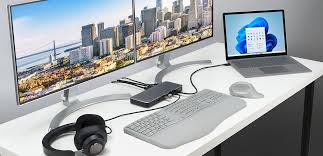Imagine a world where your laptop seamlessly transforms into a powerhouse of connectivity and efficiency. Laptop docking stations offer a gateway to this realm of enhanced productivity, providing a centralized hub for all your peripherals and devices.
But what makes these docking stations truly indispensable tools for modern professionals? Stay tuned to uncover the key benefits and features that can revolutionize the way you work with your laptop, unlocking a new level of convenience and effectiveness in your daily tasks.
Benefits of Using Docking Stations
When using docking stations, you can effortlessly enhance connectivity with your laptop. By simply docking your laptop, you gain access to a variety of additional ports such as USB, HDMI, Ethernet, and more. This means you can easily connect multiple peripherals like monitors, keyboards, mice, printers, and external storage devices without the hassle of constantly plugging and unplugging cables. Not only does this streamline your workspace, but it also saves you time and effort in setting up your devices every time you sit down to work.
Furthermore, docking stations often support multiple displays, allowing you to expand your screen real estate and boost your productivity. With dual or triple monitor setups, you can multitask more efficiently, whether you’re working on spreadsheets, editing videos, or conducting research. This enhanced display capability can greatly improve your workflow and make it easier to manage multiple applications simultaneously. In essence, docking stations provide a seamless and convenient way to optimize your laptop for enhanced connectivity and productivity.
Key Features to Look For
To make an informed decision on purchasing a laptop docking station, consider key features that align with your connectivity needs. Firstly, ensure the docking station has a variety of ports to accommodate your devices, such as USB-C, HDMI, Ethernet, and audio ports. This versatility enables seamless connection to multiple peripherals like monitors, keyboards, and external drives.
Additionally, look for docking stations that support high-speed data transfer rates, especially if you frequently work with large files or require quick data syncing.
Another crucial feature to consider is power delivery capabilities. Some docking stations can charge your laptop while connected, reducing the need for multiple chargers and cables cluttering your workspace. Compatibility with your laptop model is essential; double-check that the docking station is compatible with your specific laptop to avoid any compatibility issues.
How to Set Up a Docking Station
Ensure a smooth setup process by following these straightforward steps when connecting your laptop to a docking station.
First, place your laptop on a flat surface near the docking station. Next, connect the docking station to a power source using the provided power adapter. Then, locate the USB-C or Thunderbolt port on your laptop and plug in the docking station’s cable.
Once connected, the docking station should be recognized by your laptop, and you may need to install any necessary drivers or software for full functionality.
After the initial setup, you can start connecting your peripherals to the docking station. Attach your external monitor to the docking station’s video output ports using the appropriate cables. For additional devices like a keyboard, mouse, or external hard drive, plug them into the available USB ports on the docking station.
Best Practices for Maximizing Efficiency
For optimal performance and productivity, streamline your workflow by organizing your frequently used peripherals within easy reach of your docking station. Arrange your mouse, keyboard, external storage devices, and any other frequently accessed items close to your docking station. This simple adjustment can save you time and effort by eliminating the need to search for or reach across the desk for these essential tools.
Additionally, consider using cable management solutions to keep your workspace tidy and free of clutter. Velcro straps, cable clips, or cable sleeves can help prevent tangled cords and make it easier to connect and disconnect devices from your docking station quickly.
To further enhance efficiency, customize your docking station setup to suit your specific needs. Adjust the monitor placement, keyboard height, and mouse sensitivity to create a comfortable and ergonomic workspace that supports prolonged use without causing discomfort or strain.
Troubleshooting Common Docking Station Issues
Simplify troubleshooting common docking station issues by identifying and addressing connectivity problems efficiently. When experiencing issues with your docking station, start by checking all cable connections. Ensure that all cables are securely plugged into the docking station and your laptop. Sometimes, a loose connection can cause connectivity problems.
If the cables are all properly connected and you’re still facing problems, try restarting your laptop. A simple reboot can sometimes resolve software glitches that may be causing issues with the docking station. Additionally, make sure that your laptop’s operating system and docking station drivers are up to date. Outdated software can lead to compatibility issues.
Another common problem with docking stations is power supply. Check if the docking station is receiving power and that the power adapter is functioning correctly. If the docking station has multiple ports, test each one to determine if the issue is specific to a particular port.
Conclusion
Overall, laptop docking stations are essential tools for enhancing connectivity and productivity in your work or home office.
By providing additional ports, seamless connectivity, and the ability to easily switch between devices, docking stations streamline your workflow and make multitasking a breeze.
With the right features and setup, you can maximize efficiency and troubleshoot any issues that may arise.
Invest in a quality docking station today and watch your productivity soar.
